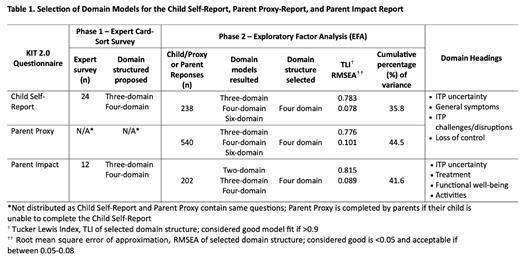Introduction
New treatment approaches have emerged for pediatric ITP over the years, potentially impacting the health-related quality of life (HRQoL) of affected individuals. The Kids' ITP Tools (KIT) (Child self-report/Parent proxy-report and Parent impact-report) have gained international attention as valid tools for monitoring HRQoL in children with ITP and the impact on their parents. The questionnaires were recently updated to reflect changes in clinical management. However, it has also become common practice to evaluate the impact of new therapies using domain scales of QOL (i.e., sub-categories), which are not yet available for the KIT. Thus, the primary objective of this study was to establish domain scales for the KIT 2.0 that accurately quantify and identify specific aspects of HRQoL that are impacted in children with ITP and their parents.
Methods
The study was conducted in two sequential phases. Phase 1 involved ITP experts identifying key conceptual domains for the KIT questionnaires based on their clinical experiences. An online survey (“card sort survey”) was distributed, and experts sorted the current KIT 2.0 questions into domains, with domain headings suggested as well. Phase 2 involved a statistical approach (i.e., exploratory factor analysis (EFA)) to yield models with different number of domains. Data from children with ITP and their parents was utilized to develop the models, and the data was specifically from three previous international multicentre studies: ITP Consortium of North America (ICON1 study), UK Children's Hospital (UK ITP Paediatric Registry), and the Children's Hospital of Eastern Ontario (KIT international validation).
Results
In Phase 1, 24 experts completed the Child self-report card-sort survey, while 12 experts completed the Parent impact survey. There were two models that were derived for the Child Self-Report, with one having three domain scales and the other with four domain scales. The Parent Impact resulted in only one model that had three domain scales.
In Phase 2, exploratory factor analysis (EFA) resulted in three models for each of the three questionnaires (Table 1), with the final models selected from the EFA and based on clinical interpretability.
The four-domain model was selected for the Child Self-Report. The model had a higher Tucker Lewis Index (TLI) score and cumulative percentage of variance compared to the three-domain model. Though the cumulative percentage of variance was higher for the six-domain model, the model had two domains that each contained only two questions, which is not ideal for face validity. The final domain headings for the Child self-report were derived from the expert card sort survey: ITP Uncertainty; General symptoms; ITP challenges/disruptions; and Loss of control.
The four-domain model was also selected for the Parent proxy-report on the basis of the same factors as the Child self-report. Likewise, the four-factor model had higher TLI score and relatively lower root mean square error of approximation (RMSEA) compared to the three-factor. The six-factor model had an ideal RMSEA, but contained one domain that had only two questions. The final domain headings are the same as the Child self-report as the context of the questions are the same.
The four-domain model was selected for the Parent impact-report. Though both the four- and six-factor models contained two domains with only two questions each, the two-factor model was not ideal clinically as the questions within each of the two domains were not all similar. The headings were also derived from the expert card-sort: ITP Uncertainty; Treatment; Functional well-being; and Activities.
Conclusion
The revised KIT 2.0 aims to comprehensively summarize health-related quality of life in pediatric patients with ITP and their parents. The introduction of a domain structure derived from expert- and patient-data to the KIT will enable identification of specific aspects of QOL that are affected, which is imperative given the introduction of novel pharmaceutical agents in ITP treatment.
Disclosures
Grace:Agios: Consultancy, Research Funding; Novartis: Research Funding; Sobi: Research Funding; Sanofi: Consultancy.


